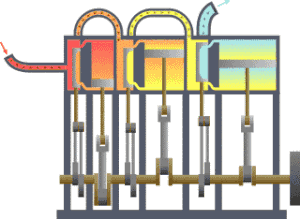
1. 열역학이란 무엇인가?
열역학은 열과 에너지의 변화를 다루는 학문으로, 열역학 법칙에 따라 열과 에너지의 전달, 변환, 저장 등을 연구합니다. 열역학은 자연과학 분야에서 매우 중요한 역할을 하며, 화학, 물리학, 기계공학 등 다양한 분야에서 응용됩니다. 열역학의 기본 개념과 법칙을 이해하면, 열과 에너지의 변화를 예측하고 제어하는 기술적인 문제를 해결할 수 있습니다.
2. 열역학 실험의 필요성과 중요성
열역학 실험은 열과 에너지 변화를 연구하는데 필요한 실험이다. 이를 통해 물질의 상태 변화, 열전달, 열역학적 평형 등을 이해할 수 있다. 또한, 열역학 실험은 산업 분야에서 열 처리 공정의 최적화와 에너지 절약을 위한 연구에도 중요한 역할을 한다. 따라서, 열역학 실험은 공학 분야에서 필수적인 실험이며, 이를 통해 새로운 기술과 제품을 개발할 수 있다.
3. 열역학 실험의 종류와 예시
열역학 실험은 열과 온도에 대한 연구를 위해 수행되는 실험으로, 다양한 종류와 예시가 있다. 대표적인 열역학 실험으로는 열전달 실험, 열팽창 실험, 열용량 실험 등이 있다. 열전달 실험은 열이 전달되는 과정을 연구하기 위한 실험이며, 열팽창 실험은 물질이 열에 의해 팽창하는 과정을 연구한다. 또한, 열용량 실험은 물질이 열을 흡수하거나 방출하는 능력을 측정하는 실험이다. 이 외에도 다양한 열역학 실험이 존재하며, 이를 통해 열과 온도에 대한 이해를 높일 수 있다.
4. 열역학 실험을 통해 얻을 수 있는 정보와 응용 분야
열역학 실험은 열과 에너지 변화를 측정하여 다양한 정보를 얻을 수 있습니다. 이를 통해 열역학적인 성질과 특성을 파악하고, 열역학 법칙을 검증할 수 있습니다. 또한, 열역학 실험은 화학, 물리학, 환경공학 등 다양한 분야에서 응용됩니다. 예를 들어, 열역학 실험을 통해 열전달 계수를 측정하여 건축물의 단열성능을 평가하거나, 화학 반응에서 발생하는 열 변화를 측정하여 반응 열학적인 정보를 얻을 수 있습니다. 또한, 열역학 실험은 신소재 개발과 같은 산업 분야에서도 활용됩니다.
5. 열역학 실험 시 주의할 점과 실험 결과 해석 방법
열역학 실험을 진행할 때는 몇 가지 주의할 점이 있습니다. 먼저, 실험 환경이 안정적이어야 합니다. 실험실 내부의 온도나 습도 등이 일정하지 않으면 실험 결과에 영향을 미칠 수 있습니다. 또한, 실험에 사용되는 기기나 시약 등은 정확하게 측정하고 사용해야 합니다.
실험 결과를 해석할 때는 열역학적인 개념을 이해해야 합니다. 열역학 제1법칙, 제2법칙 등을 이해하고 실험 결과를 이에 맞게 해석해야 합니다. 또한, 실험 결과를 그래프나 표로 나타내어 시각적으로 확인하는 것도 중요합니다.
열역학 실험은 열역학적인 개념을 이해하고 실험 환경을 안정적으로 유지하는 것이 중요합니다. 실험 결과를 정확하게 해석하여 의미 있는 결과를 도출하는 것이 목표입니다.
#열역학 #열 #에너지 #변화 #전달 #변환 #저장 #자연과학 #화학 #물리학 #기계공학 #응용 #실험 #물질 #상태변화 #열전달 #열역학적평형 #산업 #공학 #온도 #열팽창 #열용량 #성질 #특성 #법칙 #검증 #환경공학 #신소재 #제1법칙 #제2법칙 #그래프 #표 #해석
1. What is Thermodynamics?
Thermodynamics is a study that deals with changes in heat and energy, and studies the transfer, conversion, and storage of heat and energy according to the laws of thermodynamics. Thermodynamics plays a very important role in the natural sciences and is applied in various fields such as chemistry, physics, and mechanical engineering. By understanding the basic concepts and laws of thermodynamics, you can solve the technical problems of predicting and controlling changes in heat and energy.
2. Necessity and importance of thermodynamic experiments
Thermodynamics experiments are necessary experiments to study heat and energy changes. Through this, it is possible to understand the state change of matter, heat transfer, and thermodynamic equilibrium. In addition, thermodynamic experiments play an important role in research for optimization of heat treatment processes and energy saving in the industrial field. Therefore, thermodynamic experiments are essential experiments in the field of engineering, through which new technologies and products can be developed.
3. Types and examples of thermodynamic experiments
Thermodynamics experiments are experiments conducted to study heat and temperature, and there are various types and examples. Representative thermodynamic experiments include heat transfer experiments, thermal expansion experiments, and heat capacity experiments. The heat transfer experiment is an experiment to study the process of heat transfer, and the thermal expansion experiment studies the process of material expansion by heat. In addition, the heat capacity test is an experiment that measures the ability of a material to absorb or release heat. In addition to this, there are various thermodynamic experiments, which can enhance the understanding of heat and temperature.
4. Information and applications that can be obtained through thermodynamic experiments
Thermodynamics experiments can obtain a variety of information by measuring changes in heat and energy. Through this, thermodynamic properties and characteristics can be identified, and thermodynamic laws can be verified. In addition, thermodynamic experiments are applied in various fields such as chemistry, physics, and environmental engineering. For example, the thermal insulation performance of a building can be evaluated by measuring the heat transfer coefficient through a thermodynamics experiment, or the thermal change in a chemical reaction can be measured to obtain reaction thermal information. In addition, thermodynamic experiments are also utilized in industrial fields such as the development of new materials.
5. Precautions in thermodynamic experiments and how to interpret the experiment results
There are a few things to keep in mind when conducting thermodynamic experiments. First, the experimental environment must be stable. Experiment results may be affected if the temperature or humidity inside the laboratory is not constant. In addition, equipment and reagents used in experiments must be accurately measured and used.
When interpreting experimental results, it is necessary to understand thermodynamic concepts. It is necessary to understand the first and second laws of thermodynamics and interpret the experimental results accordingly. It is also important to visually confirm the experimental results by displaying them in graphs or tables.
In thermodynamic experiments, it is important to understand thermodynamic concepts and to maintain a stable experimental environment. The goal is to accurately interpret the experimental results to derive meaningful results.
#thermodynamics #heat #energy #change #transfer #conversion #storage #natural science #chemistry #physics #mechanical engineering #application #experiment #material #change of state #heat transfer #thermodynamic equilibrium #industry #engineering #temperature #thermal expansion #heat capacity #property #Characteristics #Law #Validation #Environmental Engineering #New Materials #1st Law #2nd Law #Graph #Table #Interpretation
1.熱力学とは何ですか?
熱力学は熱とエネルギーの変化を扱う研究で、熱力学の法則に従って熱とエネルギーの伝達、変換、貯蔵などを研究します。熱力学は自然科学分野で非常に重要な役割を果たし、化学、物理学、機械工学など様々な分野で応用されます。熱力学の基本概念と法則を理解することで、熱とエネルギーの変化を予測し制御する技術的な問題を解決できます。
2. 熱力学実験の必要性と重要性
熱力学実験は、熱とエネルギーの変化を研究するために必要な実験です。これにより、物質の状態変化、熱伝達、熱力学的平衡などを理解することができる。さらに、熱力学実験は、産業分野における熱処理プロセスの最適化と省エネのための研究にも重要な役割を果たしています。したがって、熱力学実験は工学分野で不可欠な実験であり、これにより新しい技術と製品を開発することができます。
3. 熱力学実験の種類と例
熱力学実験は、熱と温度の研究のために行われた実験で、さまざまな種類と例があります。代表的な熱力学実験としては、熱伝達実験、熱膨張実験、熱容量実験などがある。熱伝達実験は熱が伝達される過程を研究するための実験であり、熱膨張実験は物質が熱によって膨張する過程を研究する。さらに、熱容量実験は、物質が熱を吸収または放出する能力を測定する実験である。この他にも様々な熱力学実験が存在し、これにより熱と温度に対する理解を高めることができる。
4. 熱力学実験を通じて得られる情報と応用分野
熱力学実験では、熱とエネルギーの変化を測定することで、さまざまな情報を得ることができます。これにより、熱力学的な性質と特性を把握し、熱力学の法則を検証することができます。さらに、熱力学実験は化学、物理学、環境工学など、さまざまな分野で応用されています。例えば、熱力学実験により、熱伝達係数を測定して建築物の断熱性能を評価したり、化学反応で発生する熱変化を測定して反応熱学的な情報を得ることができます。また、熱力学実験は新素材開発などの産業分野でも活用されています。
5. 熱力学実験時の注意点と実験結果の解析方法
熱力学実験を進めるには、いくつかの注意点があります。まず、実験環境が安定している必要があります。実験室内の温度や湿度などが一定でないと、実験結果に影響を与える可能性があります。また、実験に使用される機器や試薬などは正確に測定して使用する必要があります。
実験結果を解釈するときは、熱力学的概念を理解する必要があります。熱力学第1法則、第2法則などを理解し、実験結果をこれに合わせて解釈しなければなりません。また、実験結果をグラフや表で表して視覚的に確認することも重要です。
熱力学実験は熱力学的概念を理解し、実験環境を安定して維持することが重要です。実験結果を正確に解釈して意味のある結果を導き出すことが目標です。
#熱力学#熱#エネルギー#変化#伝達#変換#保存#自然科学#化学#物理学#機械工学#アプリケーション#実験#物質#状態変化#熱伝達#熱力学的平衡#産業#工学#温度#熱膨張#特性#法則#検証#環境工学#新素材#第1法則#第2法則#グラフ#テーブル#解釈



'잡학다식' 카테고리의 다른 글
| 마취제란 무엇인가 (0) | 2023.04.13 |
|---|---|
| 금리와 인플레이션의 개념과 관계성 (0) | 2023.04.12 |
| 애리조나주의 역사와 문화적 배경 (0) | 2023.04.10 |
| 이부프로펜이란 무엇인가 (0) | 2023.04.10 |
| 이순신 군사인물의 생애와 업적 (0) | 2023.04.10 |



